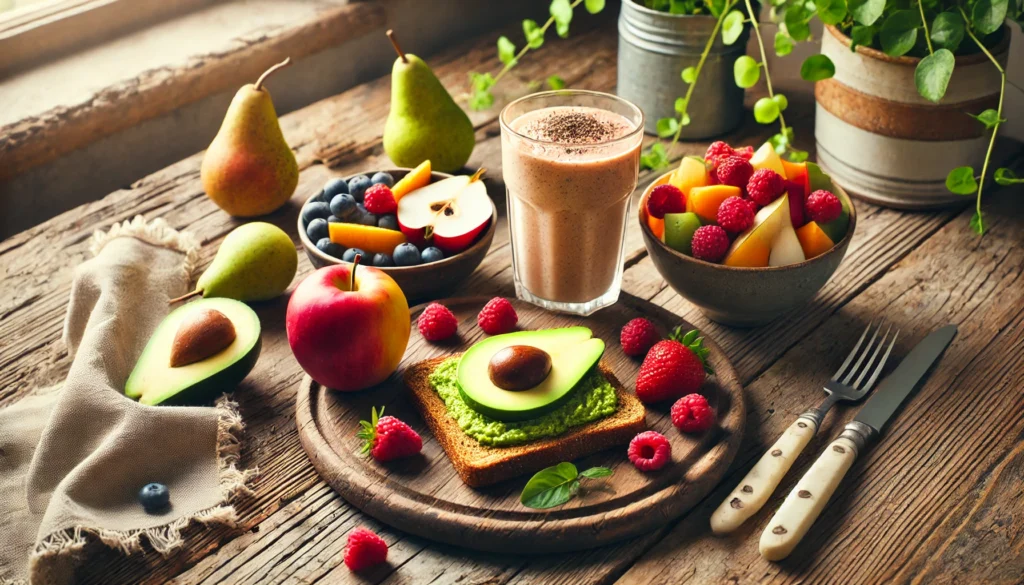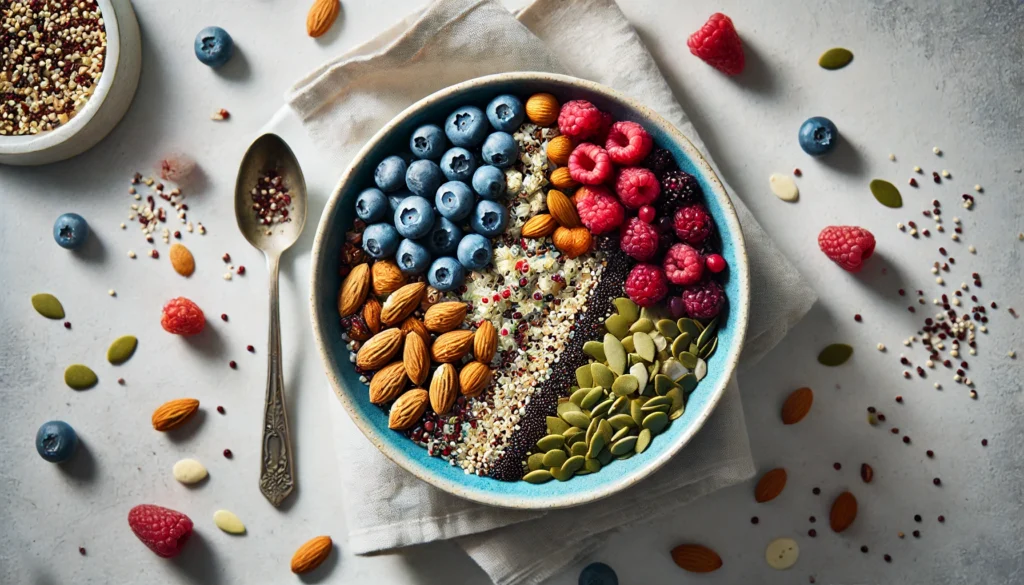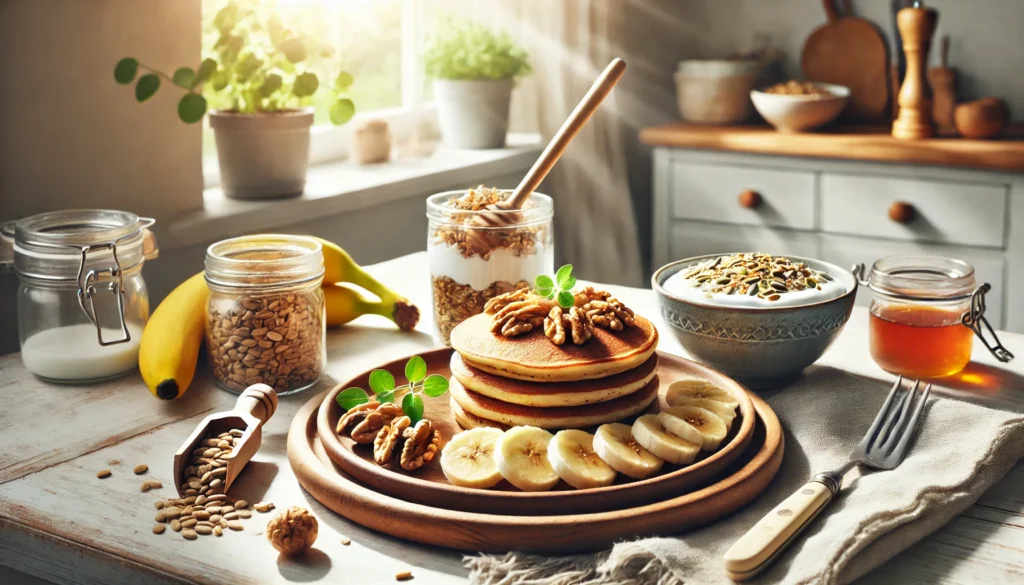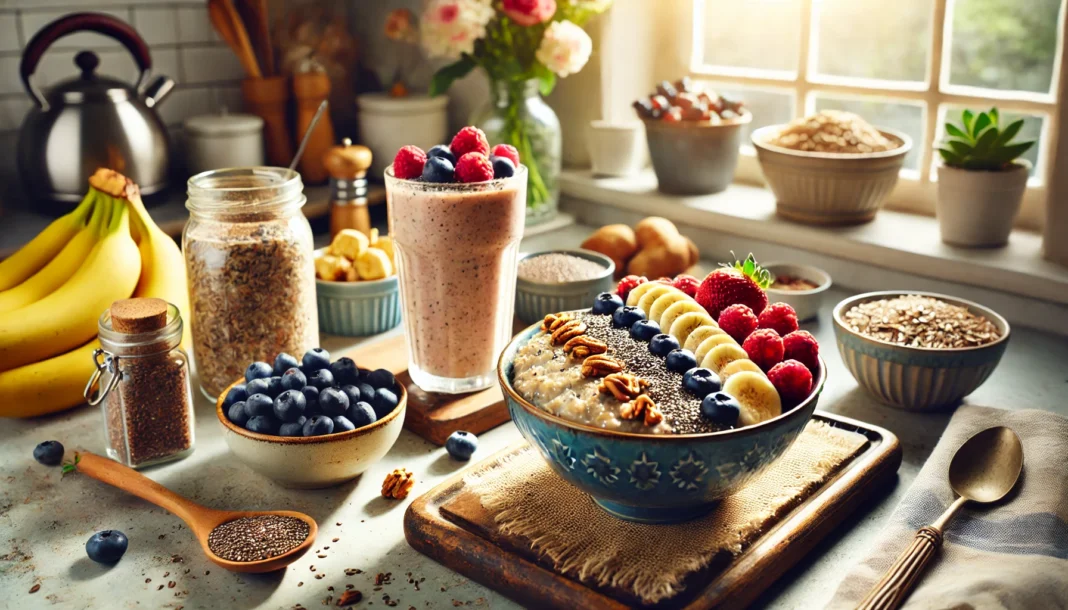The Importance of a Fiber-Rich Breakfast for Gut Health
A fiber-rich breakfast is a cornerstone of digestive health, providing essential nutrients that support gut microbiota, regulate bowel movements, and contribute to overall well-being. In today’s fast-paced world, many people neglect the significance of incorporating high-fiber foods into their morning routine. However, research consistently demonstrates that dietary fiber plays a crucial role in maintaining a healthy digestive system. This article explores the best high-fiber breakfast foods for adults, ensuring an optimal start to the day with meals that promote gut microbiome diversity and digestive efficiency.
You may also like: Fiber and Microbiome: How Gut Health Impacts Athletic Recovery and Performance
Understanding Fiber and Its Role in Digestion
Dietary fiber is classified into two primary types: soluble and insoluble. Soluble fiber dissolves in water, forming a gel-like substance that helps regulate blood sugar levels and lower cholesterol. Foods such as oats, apples, and flaxseeds are excellent sources of soluble fiber. Insoluble fiber, on the other hand, adds bulk to stool and facilitates regular bowel movements, reducing the risk of constipation. Whole grains, nuts, and vegetables are abundant in insoluble fiber, making them crucial components of a balanced diet. Both types of fiber contribute to digestive health by fostering the growth of beneficial gut bacteria and reducing inflammation within the gastrointestinal tract.

Highest Fiber Breakfast Foods to Start Your Day
A well-balanced breakfast should include fiber-rich ingredients that enhance digestion and provide sustained energy throughout the morning. Among the highest fiber breakfast foods, oats rank prominently. A single serving of oatmeal can contain up to 8 grams of fiber, particularly if topped with fiber-dense ingredients such as chia seeds, flaxseeds, and berries. Additionally, whole-grain cereals, bran muffins, and whole-wheat toast are excellent choices that contribute significantly to daily fiber intake. Incorporating legumes, such as lentils or black beans, into breakfast dishes like omelets or wraps further enhances fiber content and promotes satiety.
How Much Fiber Should Peanuts Eat for Breakfast?
Peanuts are a nutritionally dense food that offers a significant amount of dietary fiber, protein, and healthy fats. When considering how much fiber peanuts should eat for breakfast, it is essential to balance intake with other fiber sources to meet daily dietary requirements. A serving of approximately one ounce (28 grams) of peanuts provides around 2.5 grams of fiber. Combining peanuts with whole grains or fresh fruits ensures a well-rounded, high-fiber meal. Peanut butter, when spread on whole-grain toast or added to smoothies, serves as an effective way to boost fiber intake while maintaining a satisfying and nutritious breakfast.
High-Fiber Breakfast Foods for Adults
Adults require an adequate intake of dietary fiber to maintain optimal digestive function and prevent chronic conditions such as constipation, irritable bowel syndrome, and diverticulosis. High-fiber breakfast foods for adults should include a variety of whole foods that deliver both soluble and insoluble fiber. Some top choices include steel-cut oats, quinoa porridge, whole-wheat pancakes, and fiber-fortified cereals. Additionally, plant-based sources such as avocado toast on whole-grain bread, almond butter paired with banana slices, and Greek yogurt mixed with nuts and seeds offer an excellent balance of fiber, protein, and healthy fats to sustain energy levels throughout the day.
Good High-Fiber Breakfast Options for Sustained Energy
For those seeking good high-fiber breakfast options that provide lasting energy, a combination of fiber, protein, and healthy fats is key. A smoothie made with spinach, chia seeds, banana, and almond milk delivers a nutrient-dense meal packed with fiber and essential micronutrients. Similarly, overnight oats prepared with rolled oats, flaxseeds, walnuts, and mixed berries provide a balanced meal that supports gut health and sustains energy levels. Another excellent choice is a high-fiber breakfast burrito filled with black beans, scrambled eggs, avocado, and whole-wheat tortillas, offering a satisfying and fiber-rich start to the day.
Foods High in Fiber for Breakfast: A Comprehensive Guide
There are numerous foods high in fiber for breakfast that cater to different dietary preferences and lifestyles. Some of the most effective choices include:
- Whole Grains: Brown rice, quinoa, whole wheat, and barley are excellent sources of fiber that can be incorporated into breakfast meals.
- Legumes: Beans, lentils, and chickpeas contribute significantly to fiber intake when added to breakfast dishes.
- Nuts and Seeds: Almonds, walnuts, chia seeds, and flaxseeds provide a fiber boost when sprinkled over cereal or yogurt.
- Fruits: Berries, apples, pears, and bananas are rich in fiber and serve as a natural way to enhance breakfast nutrition.
- Vegetables: Leafy greens, bell peppers, and carrots can be included in omelets or breakfast wraps to increase fiber content.

Frequently Asked Questions (FAQ) on High-Fiber Breakfast Foods
1. What are the highest fiber breakfast foods, and how do they support gut health?
The highest fiber breakfast foods include oats, bran cereals, chia seeds, flaxseeds, legumes, and fiber-rich fruits like raspberries and pears. These foods contain both soluble and insoluble fiber, which aid digestion, promote a healthy gut microbiome, and regulate blood sugar levels. Fiber acts as a prebiotic, nourishing beneficial bacteria in the gut and reducing inflammation in the digestive system. Additionally, high-fiber breakfasts help maintain regular bowel movements, preventing constipation and other digestive disorders. A diverse fiber intake from different sources can enhance gut microbiota diversity, improving overall digestive wellness.
2. How much fiber should peanuts eat for breakfast to contribute to daily fiber needs?
While peanuts are a good source of fiber, they should be combined with other fiber-rich foods to meet daily intake recommendations. A one-ounce serving of peanuts provides about 2.5 grams of fiber, which contributes to the recommended 25-30 grams per day for adults. To optimize fiber intake, pairing peanuts with whole grains, fruits, or seeds can enhance nutritional benefits. For instance, peanut butter on whole-wheat toast with banana slices offers a well-rounded fiber-rich meal. Rotating fiber sources ensures balanced nutrient absorption and prevents digestive discomfort.
3. Why are high fiber breakfast foods for adults essential for long-term health?
As adults age, their digestive efficiency can decline, making fiber intake increasingly important for maintaining gut health. High fiber breakfast foods for adults help regulate cholesterol, support heart health, and reduce the risk of type 2 diabetes by slowing glucose absorption. Fiber also promotes satiety, which can aid in weight management by preventing excessive calorie consumption. Furthermore, adequate fiber intake is linked to lower risks of colorectal cancer, making it a crucial component of a long-term healthy diet. A well-balanced breakfast including fiber from multiple sources can ensure optimal digestive and metabolic benefits.
4. What are some good high fiber breakfast ideas for people with busy schedules?
For those with busy mornings, quick and easy fiber-rich breakfast options include overnight oats with chia seeds, whole-grain toast with avocado, and high-fiber smoothies with flaxseeds and berries. Pre-made high-fiber energy bars or bran muffins can also be convenient choices for on-the-go consumption. Meal prepping high-fiber breakfast foods in advance, such as baking whole-wheat muffins with nuts and dried fruit, ensures accessibility and nutritional balance. Incorporating fiber-rich breakfast items into daily routines does not have to be time-consuming and can be tailored to personal preferences. Choosing nutrient-dense ingredients supports sustained energy and digestive health throughout the day.
5. What are the best foods high in fiber for breakfast for people with sensitive digestion?
People with sensitive digestive systems should prioritize gentle sources of fiber, such as oatmeal, bananas, cooked apples, and ground flaxseeds. Soaking chia seeds before consuming them can make them easier to digest while still providing ample fiber. Opting for warm, cooked grains like quinoa or brown rice porridge can also aid digestion without causing bloating or discomfort. Yogurt with added fiber from ground flaxseeds and a drizzle of honey offers a probiotic and prebiotic combination that is soothing for the gut. Gradually increasing fiber intake and drinking plenty of water can help minimize digestive distress while still reaping fiber’s benefits.
6. How do fiber-rich breakfasts impact energy levels and focus?
A fiber-rich breakfast helps stabilize blood sugar levels, preventing energy crashes and maintaining focus throughout the day. Unlike refined carbohydrates, which cause rapid spikes and dips in glucose levels, high-fiber foods provide a slow, steady release of energy. Combining fiber with protein and healthy fats, such as a smoothie with spinach, chia seeds, and almond butter, further enhances sustained energy. This balance ensures that mental clarity and cognitive function remain optimal, particularly for individuals with demanding work or academic schedules. Consistently choosing fiber-packed breakfasts supports long-term energy regulation and productivity.
7. Can a high-fiber breakfast aid in weight management?
Yes, consuming high-fiber foods in the morning can promote satiety, reducing overall calorie intake throughout the day. Fiber expands in the stomach, creating a feeling of fullness that can help curb cravings and prevent overeating. Foods such as whole-grain cereals, beans, and fibrous fruits provide volume without excessive calories, supporting weight management goals. Additionally, fiber slows digestion, which prolongs the feeling of satisfaction after eating. Maintaining a diet rich in fiber is an effective strategy for controlling appetite and sustaining healthy weight loss or maintenance.
8. What are some creative ways to increase fiber intake at breakfast?
Incorporating fiber into breakfast can be done creatively by adding flaxseeds or chia seeds to smoothies, yogurt, or pancake batter. Using whole-grain alternatives like barley or buckwheat instead of refined grains boosts fiber content in traditional breakfast dishes. Homemade granola with nuts, seeds, and dried fruit is another flavorful way to increase fiber intake. Replacing regular breakfast wraps with whole-wheat or sprouted grain tortillas enhances fiber without compromising taste. Exploring new fiber-rich ingredients like psyllium husk or teff can diversify breakfast options while supporting digestive health.
9. How do cultural dietary patterns influence fiber intake at breakfast?
Cultural variations in breakfast foods affect fiber consumption, with some diets naturally emphasizing fiber-rich ingredients. Traditional Mediterranean breakfasts often include whole grains, nuts, and legumes, while Asian diets incorporate fiber-rich fermented soy products and vegetables. Latin American diets commonly feature fiber-dense staples like black beans, plantains, and corn-based dishes. Western diets, particularly in industrialized nations, tend to be lower in fiber due to processed food consumption, highlighting the need for conscious dietary adjustments. Learning from diverse global diets can inspire new, fiber-rich breakfast choices tailored to individual preferences.
10. What future trends are emerging in high-fiber breakfast foods?
The future of high-fiber breakfast foods includes innovations such as fiber-enriched functional foods, prebiotic-fortified cereals, and gut-health-focused meal replacements. Advances in food technology are introducing novel plant-based fiber sources, including resistant starches and fermented grains, to enhance digestive benefits. Personalized nutrition, driven by gut microbiome testing, may soon allow individuals to tailor fiber intake based on their unique digestive needs. Additionally, the rise of plant-based eating continues to drive demand for high-fiber, protein-rich breakfast options. As research on gut health expands, fiber-focused breakfast formulations will likely play a key role in optimizing nutrition and overall well-being.

Conclusion: Elevate Your Breakfast with High-Fiber Choices
Incorporating the best high-fiber breakfast foods into your daily routine supports digestive wellness and overall health. By selecting a variety of fiber-rich ingredients, individuals can enhance gut microbiota diversity, regulate digestion, and maintain sustained energy levels. Whether through oatmeal, whole grains, nuts, seeds, or fruits, making mindful dietary choices in the morning establishes a foundation for long-term well-being. As research continues to highlight the critical role of fiber in gut health, prioritizing fiber-rich breakfast options remains an essential step toward achieving optimal digestive and metabolic function.
Further Reading:
25 High-Fiber Breakfasts to Try for Good Gut Health
What Is a Good High Fiber Breakfast?
GI doctors reveal what they eat for breakfast — and the foods they avoid
gut health nutrition, fiber-rich diets, best breakfast for digestion, healthy morning meals, plant-based fiber sources, improving digestive wellness, gut-friendly foods, high-fiber meal ideas, whole grains for breakfast, dietary fiber benefits, breakfast foods for gut flora, best foods for bowel health, natural sources of fiber, fiber and metabolism, weight management breakfast, prebiotic foods for gut health, fiber and heart health, balanced breakfast ideas, fiber intake recommendations, healthy eating habits
The information contained in this article is provided for general informational purposes only and is not intended to serve as medical, legal, or professional advice. While NewsHealthWatch strives to present accurate, up-to-date, and reliable content, no warranty or guarantee, expressed or implied, is made regarding the completeness, accuracy, or adequacy of the information provided. Readers are strongly advised to seek the guidance of a qualified healthcare provider or other relevant professionals before acting on any information contained in this article. NewsHealthWatch, its authors, editors, and contributors expressly disclaim any liability for any damages, losses, or consequences arising directly or indirectly from the use, interpretation, or reliance on any information presented herein. The views and opinions expressed in this article are those of the author(s) and do not necessarily reflect the official policies or positions of NewsHealthWatch.

